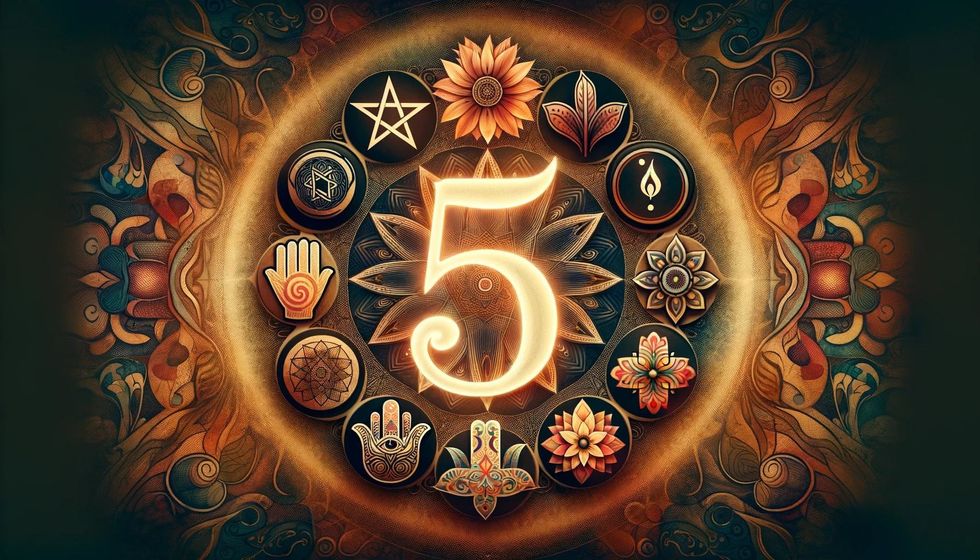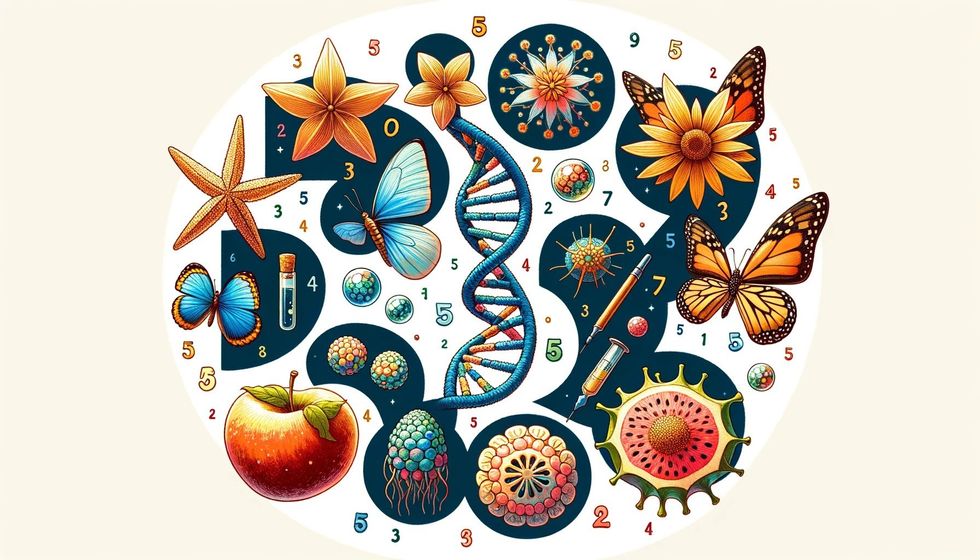The number 5 is renowned in numerous cultures and historical contexts for its representation of diverse and significant concepts. More than a mere tool for counting, it holds symbolism in celestial observations and beloved sports.
The number 5 can also be seen on the human body because of the five senses, and five fingers and toes on each hand and foot.
Astronomy points out that there are five special spots called Lagrange points in outer space. These points show us how the number 5 is also a part of the way things move and stay put up in the sky.
Mathematics also appreciates the number 5 through its basic properties, such as the commutative, associative, distributive, and identity properties, which are foundational to understanding mathematical operations.
The number 5 is also common when we just go about our day. For example, some top athletes wear it on their jerseys because it says they're good at what they do. The five rings we see in the Olympics show how people from all the big land areas of the world can come together and be friends.
Whether it's used to understand something deep or just for fun, the number 5 continues to show how everything is connected and fits together nicely, which makes it a beacon of teamwork, fairness, and being a part of something bigger.
Is the number 5 a prime number or an odd number?

Exploring the essential properties of numerical values uncovers the unique aspects of the number 5. As a figure central to various mathematical concepts, its special features stand out in the realm of numbers.
- The number 5 is classified as a prime number because its only factors are 1 and 5, meaning it cannot be evenly divided by any other positive integer.
- The number 5 is also recognized as an odd number since it cannot be divided evenly by the number 2.
- The number 5 is the 3rd prime number and the 5th Fibonacci number.
- The number 5 is a balanced prime, being at an equal distance from the previous prime 3, and the next prime 7.
- The number 5, being a prime, is a key example that illustrates the theorem. It cannot be broken down further into other primes.
- The rules for divisibility are clear when it comes to the number 5, if the last digit is either 5 or 0, the entire number can be divided by 5.
- The number 5 is essential in several math concepts and theorems, especially when it comes to understanding prime factorization and the rules for divisibility.
From Five Platonic Solids to the Pentagon

The number 5 is prominent in geometry and the natural world, evident in structures such as the five Platonic solids and the pentagon. This number is also manifest in biological forms like the five-petaled wild rose.
The five-pointed star, or pentagram, not only follows the golden ratio, emphasizing its mathematical importance, but it also carries historical symbolism of harmony and significance.
- In the 6th century BCE, the Pythagoreans adopted the pentagram as a symbol of recognition, naming it 'Hugieia'. They were captivated by its mathematical precision and golden ratio proportions. The pentagram's five points were possibly symbolic of health, the known planets, or the human form.
- In the three-dimensional space, there are strictly five regular polyhedra possible, tetrahedron, cube, octahedron, dodecahedron, and icosahedron, a fact that greatly intrigued the ancient Greeks.
- A pentagon is characterized by its five equal sides and angles, with the sum of its internal angles always adding up to 540 degrees.
- By joining alternate corners of a pentagon, one can inscribe a pentagram inside it, showcasing the intimate geometric link between these two shapes.
- Flowers like roses and apple blossoms often display a five-fold symmetry in their petal and seed arrangements, echoing the geometric structure of pentagons and pentagrams.
- The diagonals within a pentagon intersect at points that divide each other in the golden ratio, a proportion found extensively in nature and classical architecture.
- Astronomer Johannes Kepler once sought to connect the orbit of planets with the five Platonic solids, attributing divine connotation to their geometric aspects, prior to formulating his laws of planetary motion.
- The five-pointed star has contemporary significance as well and is seen on the U.S. flag, the flag of the European Union, military emblems, and badges for police and emergency services.
The Number 5 in Culture and Symbolism

The number 5 holds rich cultural and symbolic meanings across various traditions worldwide. From spiritual significance to lucky associations, the number 5 appears prominently in religion, mythology, and even modern popular culture.
- Within Christianity, the number 5 holds deep spiritual meaning, representing God's grace and kindness towards humanity. It is reinforced by the five books of the Pentateuch and the quintet of ministries within the church.
- The Pythagoreans from ancient Greece honored the five-pointed star, attributing mystical significance to its mathematical properties and using it as a recognition symbol.
- The number 5 in China correlates with the five central elements and historically, it signified imperial power.
- In Islam, the number 5 reflects the Five Pillars of Islam, with adherents praying five times daily as a sacred practice.
- The five-color composition of the five Olympic rings stands for the union of the world's five continents in global athletic events, with each hue represented on the flags of the participating nations at the time of their creation.
- Sikhism's Panj Kakkar symbolizes faithfulness, embracing five physical articles of faith that followers wear to express religious commitment.
- Based on the Law of Fives, Discordianism views the number 5 as sacred, insisting that all occurrences are connected to the number in some form.
- For the ancient Babylonians, the pentagram held cosmic relevance, linking the five visible planets to the five elements.
- In Cantonese, the number 5 sounds like the word for 'not' or 'no', so giving five of something is considered unlucky and symbolizes bad luck or lacking something.
The Number 5 in Nature and Science

The number 5 appears frequently in the natural world, from the five-fold symmetry of many flowers to the five fingers or toes of most mammals. In science, the number 5 is significant as the atomic number of boron and in describing the geometrical structure of many molecules and crystals.
- Boron, which has the atomic number 5, and is the fifth element plays a crucial role in plant growth by aiding the formation and strengthening of cell walls.
- Wild roses and many other flowers display a star-like arrangement with five petals, reflecting a common pattern of five-fold symmetry in plants.
- Echinoderms, such as starfish and sea urchins, are characterized by pentaradial symmetry, where their body parts are organized in groups of five or multiples thereof.
- A typical trait among most amphibians, reptiles, and mammals is the presence of five fingers or toes on each limb.
- The simplest form of stable alkane is pentane, an organic molecule with a chain of five carbon atoms.
- In space, five Lagrange points allow for the stable orbit of smaller objects in conjunction with two larger ones, such as the Earth and the Sun, proving strategic for placing astronomical equipment.
The Number 5 in Everyday Life

The number 5 plays a subtle yet important role in everyday life, revealed through our basic senses and the framework of language. Five vowels anchor speech across languages, demonstrating the number's broad influence.
- The traditional five human senses are sight, hearing, touch, smell, and taste, which are essential for perceiving and interacting with our surroundings.
- Within the English alphabet, there are five vowels: a, e, i, o, and u, which are crucial for forming spoken and written words in the language.
- Words containing five syllables, such as 'unbelievable', 'investigation', or 'communication', are known as pentasyllabic.
- Human anatomy generally includes five fingers on each hand and five toes on each foot, a feature common to most mammals.
- In the scoring system of baseball, the third baseman is traditionally assigned the number 5.
- Starfish, a species of marine life, are recognized for their pentaradial symmetry, which means their bodies consist of five equal parts radiating from a central area.
- A musical quintet refers to either a piece of music designed for five instruments or vocalists or to a group comprising five musicians.
FAQs
What makes the number 5 a prime number?
The number 5 is considered a prime number due to its unique divisibility properties. It belongs to a special group of numbers that can only be divided evenly by two distinct factors: the number 1 and the number itself.
In other words, when dividing the number 5 by any positive integer other than 1 and 5, there will always be a remainder. This characteristic is the defining feature of prime numbers, which are positive integers greater than 1 that have exactly two factors.
Why is the number 5 important in geometry?
In geometry, the number 5 is significant due to its connection to the five Platonic solids (tetrahedron, cube, octahedron, dodecahedron, icosahedron), which are the only regular polyhedra possible in three-dimensional space. The dodecahedron, in particular, has pentagonal faces.
The number 5 is also associated with the pentagram, a five-pointed star polygon with intriguing mathematical properties related to the golden ratio.
How is the number 5 represented in nature?
The number 5 appears frequently in nature, such as in the five-fold symmetry of many flowers (e.g., wild roses, buttercups), the five-pointed leaves of some plants, and the five arms or rays of echinoderms like starfish and sea urchins. Many fruits, such as apples and pears, have a five-part core structure that reflects the five-fold symmetry of their flowers.
What is the cultural or spiritual significance of the number 5?
The number 5 holds cultural and spiritual significance in various traditions worldwide. In Christianity, there are five wounds of Christ. In Hinduism, the god Shiva has five faces. In Islam, there are five pillars of the faith, and Muslims pray five times a day.
In the Gregorian calendar, May is the fifth month of the year and is often associated with growth, renewal, and celebration in many cultures. For example, May Day (May 1st) is a traditional spring festival in many parts of Europe, while Cinco de Mayo (May 5th) is a significant celebration of Mexican heritage and pride.The number 5 holds cultural and spiritual significance in various traditions worldwide. In Christianity, there are five wounds of Christ. In Hinduism, the god Shiva has five faces. In Islam, there are five pillars of the faith, and Muslims pray five times a day.
In the Gregorian calendar, May is the fifth month of the year and is often associated with growth, renewal, and celebration in many cultures. For example, May Day (May 1st) is a traditional spring festival in many parts of Europe, while Cinco de Mayo (May 5th) is a significant celebration of Mexican heritage and pride.
How does the number 5 feature in sports?
The famous Olympic rings logo consists of five interlocking rings in five colors (blue, yellow, black, green, and red), representing the five inhabited continents and the meeting of athletes from around the world at the Olympic Games.
Can you explain the importance of the number 5 in human anatomy?
The number 5 is reflected in several aspects of human anatomy. Humans have five fingers on each hand and five toes on each foot. We also classically recognize five senses: sight, hearing, touch, smell, and taste. Additionally, the human body has five main parts: the head, two arms, and two legs.
Is the number 5 lucky or unlucky?
The perception of the number 5 varies by culture; it is considered lucky in some traditions due to positive associations, while in others, it might be seen as unlucky for differing reasons.
How does the number 5 relate to astronomy?
The number 5 is closely connected to the golden ratio (approximately 1.618), an aesthetically pleasing proportion found throughout nature and art. The golden ratio is related to the Fibonacci sequence, in which each number is the sum of the two preceding ones.
The further along the Fibonacci sequence (which includes 5), the closer the ratio of adjacent numbers approaches the golden ratio.
The number 5 is significant in numerous contexts, from its presence in architectural designs to its role in musical compositions. It is a prime and Fibonacci number, influencing a wide range of fields such as nature, language, the arts, and even the economy, as seen in currencies like the five-pound note.
This commonness underlines its importance as a symbol with various meanings and implications across cultures and disciplines.
Related Articles Around the Web














